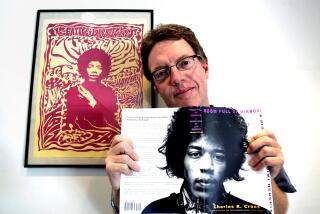An Ugly Jazz Story : MILES The Autobiography <i> by Miles Davis With Quincy Troupe (Simon & Schuster: $22.45; 416 pp.) </i>
As if the biographies and movies dealing with the narcotics problems of Billie Holiday, Art Pepper, Hampton Hawes, Bud Powell, Anita O’Day, Charlie Parker and Chet Baker were not enough, we are now confronted by the dreary, drug-ridden story of Miles Davis, which he had assured his public would be a book about music.
As it turns out, the grinding monotony of these pages too often relegates music to secondary consideration, while interminable passages deal with the women he has beaten up, the musicians and managers he has fought with, and his off-on-off-on-off-on relationship with cocaine, heroin and other mind-altering impedimenta.
What has long been an open secret is now in print: “From 1975 to early 1980 I didn’t pick up my horn,” Davis says. “Mostly during those four or five years . . . I just took a lot of cocaine (about $500 a day at one point) . . .” He also had sex with “all the women I could get into my house. I was also addicted to pills, like Percodan and Seconal, and I was drinking a lot . . . mostly I snorted coke, but sometimes I would inject coke and heroin into my leg; it’s called a speedball and it was what killed John Belushi.”
Clearly it did not kill Miles Davis, but over the years dope ruined his health, his career and his marriages. Yet there is not enough mea culpa to sound a cautionary note; he gladly admits that he “really enjoyed” getting high on champagne, beer, Cognac and cocaine.
“Miles” begins as the story of a black boy who grew up with advantages that were unusual for any musician. His father, an oral surgeon in East St. Louis, prospered even during the Depression. His mother wore mink. While other black kids were struggling to escape from the ghetto, Miles Dewey Davis III was riding horses on a large family estate, or serving on the golf course as a caddy for his daddy.
His parents sent him to study at Juilliard, but after a year there he preferred the company of beboppers. Barely out of his teens, on tour with the Billy Eckstine orchestra, he began using cocaine and heroin, starting a 5-year descent into a hell from which his father tried to rescue him.
The irony is that Davis’ work, with its scurrility and pragmatic sensationalism, will reach the best seller lists. Moreover, it will be praised for its “painful honesty,” though in fact it is riddled with major and minor factual errors that indicate dishonesty and sloppy research. Typically, after lambasting the promoter Monte Kay for making money off black people, he says that “today he’s a millionaire living in Beverly Hills.” Kay never lived in Beverly Hills; also, he died in May 1988. In another instance, Davis claims that many white musicians, after working for black leaders and being nobly treated by them, go out on their own and use only white sidemen, and that the late pianist Bill Evans was one such white man. The truth is that Evans, after leaving Davis, used the black drummer Philly Joe Jones, the black bassist Rufus Reid, and recorded with several other black artists.
This is, in fact, an often untruthful, frequently ugly book without the slightest redeeming value as literature. Its almost inevitable acceptance in the marketplace bodes ill for the future documentation of musicology.
More to Read
The biggest entertainment stories
Get our big stories about Hollywood, film, television, music, arts, culture and more right in your inbox as soon as they publish.
You may occasionally receive promotional content from the Los Angeles Times.










